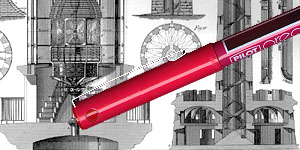


Video Games with Real Blood
For decades now, the cockpits of warplanes have come more and more to look like an explosion in a video arcade. To combat the clutter, pilots of today's most advanced warplanes now have see-through displays in front of their windscreens---or, more recently, two tiny video screens built right into their helmets. When flying at night, these video pilots no longer see reality. They see a computer-generated abstraction of the cockpit instruments, terrain, and nearby warplanes. That lets them track missile readiness, combat damage, flight information, and enemy locations while keeping an eye on what's happening outside.For its weight and size, an advanced warplane is one of the most expensive machines on the planet. Aircraft costs have quadrupled every decade for the past eight decades, and extensively training pilots to use one is a luxury most nations simply can't afford. Over sixty years ago, therefore, advanced air forces started using (noncomputer) simulators to train their pilots. These machines tried to mimic the plane's behavior, giving the pilot a feel for what things might be like in the real cockpit. Of course, they were crude. But as computer technology matured and the expense of real planes skyrocketed, the simulators improved so much that it's now easy to believe you're in a real plane.
Besides training pilots, simulators are now also used to train ship and submarine crews, tank and artillery operators, and even missile-battery and ground attack troops. The American military, for instance, already has a few hundred tank, missile-battery, armored vehicle, and aircraft simulators linked in a global network---an entire army online. That network will soon simulate all aspects of war, from individual tank movements to the strategic maneuvering of whole armies. So tank crews in Germany could work with air crews in Saudi Arabia and artillery crews in California to fight a simulated war against their counterparts, who are also scattered across the globe.
Computers can simulate the landscape the pilot or tank operator would see if flying or driving over it---every river, every tank, every telephone pole---and they can manage the various weapons. Computers can immerse combatants in a shared but artificial battlefield despite their physical separation. The synthetic battlefield lets simulated munitions lobbed in Germany "hit" in California a few seconds later, just as if the gun and its target were near each other. Computers can even simulate a horde of enemies, basing their reactions on information about how they usually respond.
Advanced tanks are already one step away from reality anyway. Often their operators only see a computer-massaged version of the outside world through periscopes. Twiddling the knobs and dials and looking into the computer monitor to judge the effect, tank crews easily accept a simulated battle as a real one---except for the smell. Replaying the same battle in dozens of different sequences trains them to use the tank as if it were part of their own bodies so that responses become second nature. Such preparation is invaluable when real war comes.
Without combat-level practice, peacetime military forces turn to mush. Simulated war helps them weed out poor combat performers. And, while nowhere near as realistic, simulators are a lot cheaper than open-air military exercises. Armed forces that can afford simulated war are fielding near-veterans with extensive knowledge of the foe's own terrain.
Of course, simulated war will never equal real war---unless we're prepared to kill some of our soldiers during training. Nonetheless, American tank operators deep in the bowels of a plastic tank simulator bolted to the floor in Kentucky can battle each other just as if they were in the arid deserts of Saudi Arabia or the rolling hills of Germany. These troops aren't on the frontline, they're online.